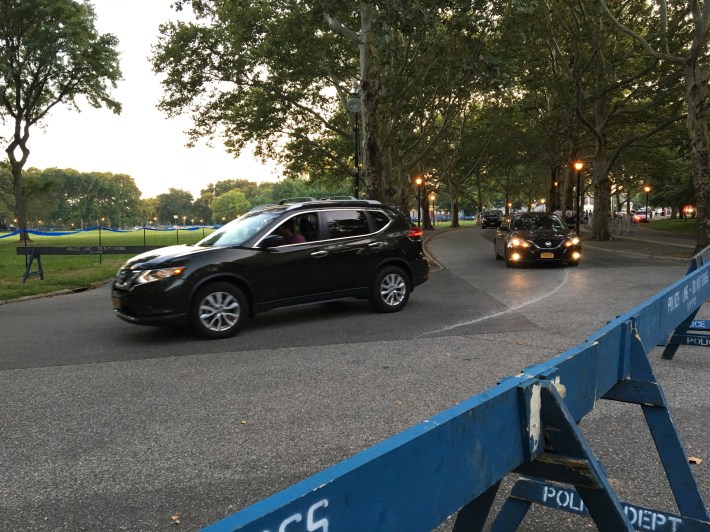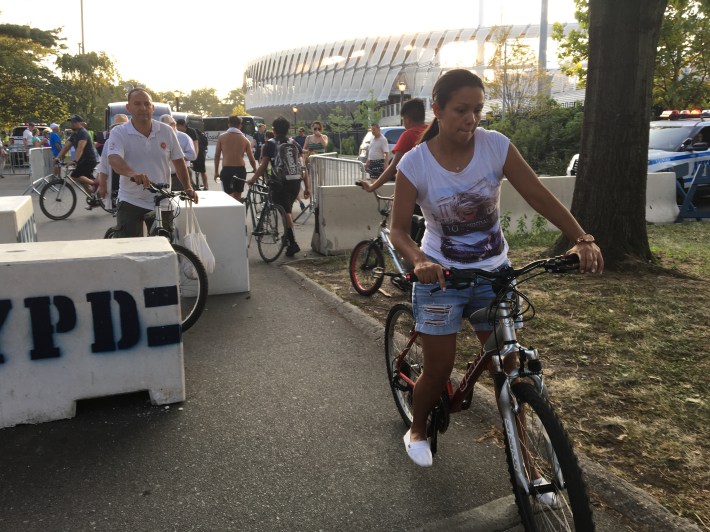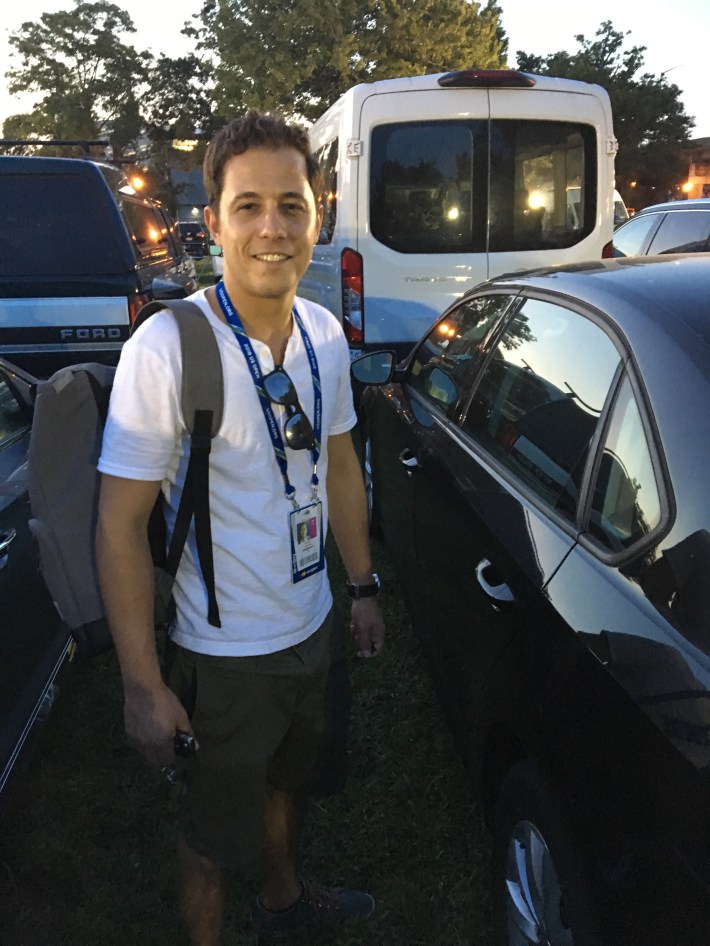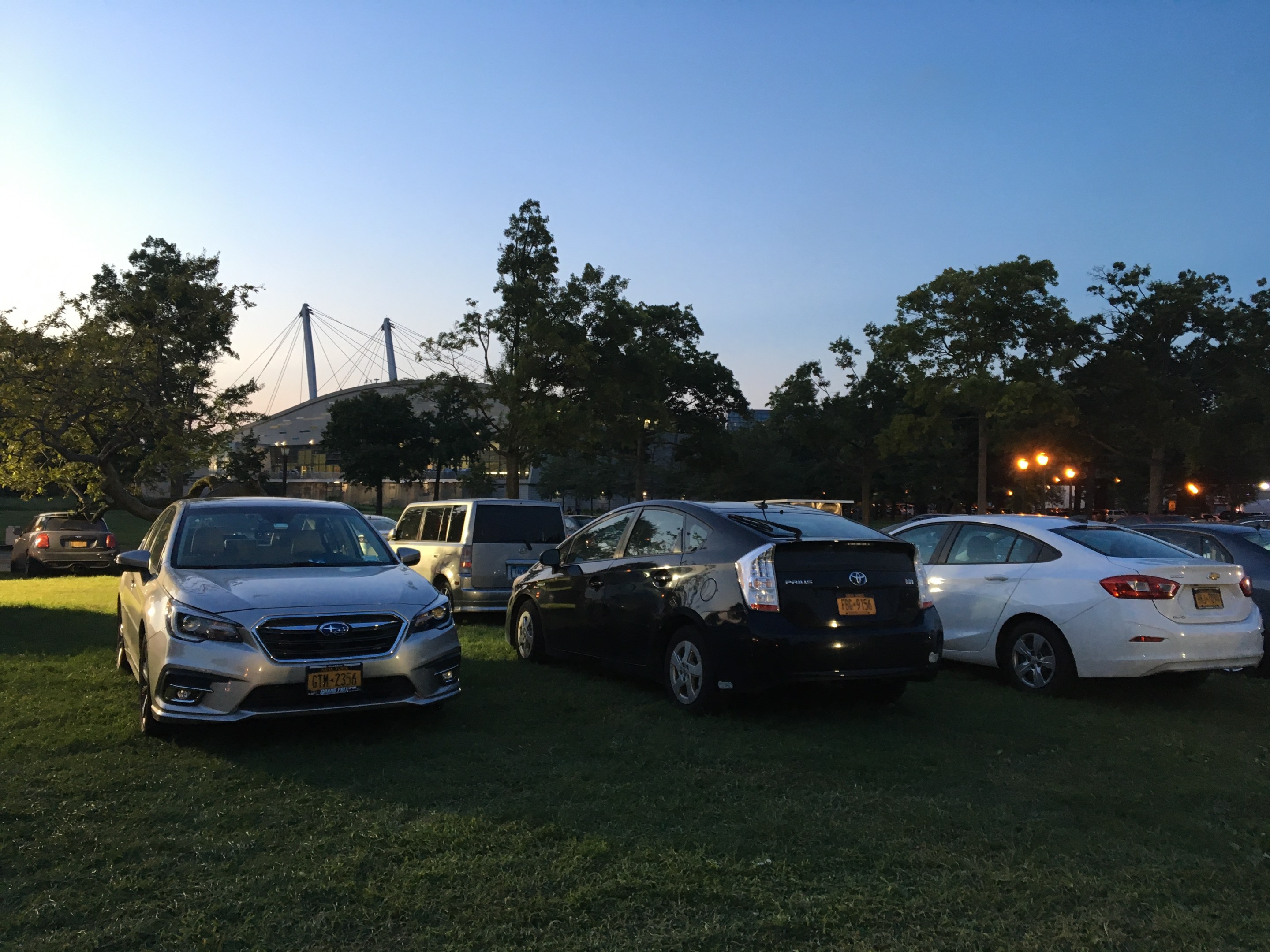Flushing Meadows Corona Park is once again Flushing Meadows Corona Parking Lot, thanks to the U.S. Open.
Now through the end of the tennis tournament next week, Queens’ most important green space is a riot of large coach buses parking on cycling and pedestrian paths, NYPD vehicles stored everywhere, concrete bollards narrowing key routes, and picnic areas turned into car storage for drivers.
Park and community advocates denounce the imposition annually, but apparently, it’s news to Mayor de Blasio.
“I have to be straight up with you: no one has raised that as a problem to me that I can remember,” the mayor said on Tuesday in response to a question from a reporter about the hypocrisy of supporting car-free Central and Prospect parks yet allowing Flushing Meadows to be overrun with cars for three weeks every summer.
“I think there’s a recognition that the U.S. Open is a tremendously positive event for the city in every way, including economically. So, I think it’s just an apples and oranges situation. It’s very fair to say, ‘Is it worth it?’ I think as a matter of policy, right now we say [it is], but if there is a concern about the number of cars during the U.S. Open, I’m happy to look at it. It’s just the first time I’ve ever heard it raised.”
Flushing Meadows Corona Park is the city’s third largest and the home of cultural institutions and amenities, including the iconic Unisphere, Queens Museum, Queens Theater, Queens Zoo, New York Hall of Science, an aquatic center, a playground for children with disabilities, a boat house and several others.
The park is beloved by Queens residents who frequent the park for soccer, volleyball, cricket, picnics, barbecues, parties and even just to walk, bike, and breathe.
The United States Tennis Association’s occupation adds another layer of injustice to the list of discrepancies between Queens’ largest park and those in other boroughs. Flushing Meadows Corona Park-goers dodge drivers who speed off highway ramps directly into the park, whose paths are crumbling from lack of maintenance. These conditions do not persist in Prospect and Central parks, which have large conservancies advocating for their maintenance. Safe streets advocates in Brooklyn and Manhattan recently celebrated their flagship parks going permanently car-free, but the U.S. Open makes an already bad situation worse for Queens cyclists and pedestrians.

“The message I got was that bicycles are not welcome at the U.S. Open,” said John Choe, who biked from his office at the Flushing Chamber of Commerce to the U.S. Open on Aug. 27. Choe was preparing to staff the Queens Tourism Council’s tourism booth, but found that his normal access point from Flushing, near College Point Boulevard and Avery Avenue, was obstructed by the security forces, as were paths along the stadium.
For local residents, the park provides scarce green space to play and relax. For bike commuters, like Eric Harold, the park is the safest route from North Flushing to his job as an aircraft mechanic at LaGuardia Airport given the limited options for traveling between Eastern and Western Queens.
Harold does not bike to work during the U.S. Open because the park is “full of out-of-state drivers who think it’s a highway, not a park. They think you being there on a bike is wrong. The U.S. Open caters to them and they forget the park is used by city residents.”
The U.S. Open is only a three-week disruption, but for teenagers like Jackson Heights resident Sammy Dib, it comes at the worst time — just as they are enjoying the last bit of summer before school returns.
“It’s a lot harder to bike here,” said Dib, as he and his friends navigated their bikes through the NYPD’s maze of concrete blocks. “It’s like Super Mario. There are a lot of obstacles, people and cars: that’s the thing I fear.”

The Open physically occupies swaths of parkland and imposes many “trickle-down impacts” including increased traffic and limited parking for regular activities, according to Jackson Heights resident Donavan Finn. Finn would prefer to avoid the park during the Open, but his child attends camp at the Queens Zoo, and smaller parks in his neighborhood, Travers and Bulova are closed for renovations.
“It’s like an invading army swooped down,” he said. “The facility has a big black gate around it and it towers over the park. For 50 weeks per year, the tennis stadium is this foreboding fortress. For two weeks it kind of explodes. This brazen opulent capitalism is on display for two weeks and then it retreats into itself.”
Or course, Open fans — at least the ones who don’t live in Queens — don’t have a problem with that.
“The U.S. Open is the number one tax generator for the whole city,” Manhattan resident Maura McGrath wrongly stated, as she waited for a cab to pick her on a bit of parkland. (Broadway and the real estate industries generate far more tax revenue for the city.) “If it takes a little bit of abuse, it’s ok because the hotels, cabbies, and restaurants are getting extra revenue from the tourists visiting the city.”
Some of the security measures hinder park-goers access and ability to navigate, but their conspicuous presence highlights the permeability of the park’s cyclist and pedestrian-dense areas throughout the rest of the year. The park paths lack physical barriers or signage discouraging vehicle operators from mixing with the cyclists and pedestrians, enjoying the park at their leisure.
Cement barricades 2 protect people from possible car attacks BUT only during #USOpen The rest of the year #FMCP is wide open for cars & trucks 2 attack, I mean drive #bikenyc #flushing #Corona #BikeQNS @NYCMayorsOffice @NYCParks @NYCCouncil @CMPeterKoo @FranciscoMoyaNY @TransAlt pic.twitter.com/vv9x21DsAs
— Eric Harold (@eric7anthony) August 25, 2018
The Grand Central Parkway bisects the park like a scar and there are only two bridges across it, one near the Queens Theater and one near the tennis stadium and the Queens Museum. As a temporary measure for the Open, the southern bridge has a concrete barrier placed across it to restrict vehicle access, while allowing people to walk or bike freely. Drivers frequently go there during other parts of the year, when the barrier is absent.
The northern bridge is always shared by drivers, cyclists, and pedestrians, but most of the year its quiet and car use is sparse. During the U.S. Open, the bridge, which runs directly from the Tennis Stadium to the Hall of Science, is dangerously congested with turning buses, shuttles, and golf cars. Cyclists are impeded by a concrete block configuration — and pedestrians can cross. But impatient drivers consistently honk aggressively at the non-motorized park users.
Besides inconveniencing and deterring regular riders, the U.S.T.A, which hosts the event, does little to encourage attendees to explore the surrounding community, which is home to a wide variety of ethnic eateries and culture. Indeed, why would drivers seek out other opportunities when U.S.T.A. commandeers green space, such as an area near the aquatic center that is normally used for soccer games and cricket matches, for parking lots?
“I never saw so many cars on public space. It was almost like a car auction,” said Choe, the cyclist. “I just felt like I was in a police state because normally this is a public park for cyclists and pedestrians. Our movement was so restricted, meanwhile cars were driving and parking everywhere. It was a free for all for parking.”
The only bike parking available near the venue is a single overflowing rack adjacent to the Queens Museum parking lot.

Each half hour, some attendees ran straight from the tennis compound to the Jitney buses idling in the Queens Museum’s parking lot, each bearing a label of the posh Manhattan hotel to which it was bound: Grand Hyatt, Intercontinental, Weston, etc.
Meanwhile, Kevin Eppolito was parking his car — for free — on the grass near the Aquatic Center. He told Streetsblog that he drove from Bergen County, N.J. to the Open for a simple reason:
“I drove because it’s the easiest,” he said.
Given how the U.S.T.A. treats park users and the park itself during the Open, he’s probably right.






